Assessing the Quality of New PUE Technologies: From Egg Incubators and Beyond
Solar productive use equipment (PUE), which encompasses solar mills and egg incubators, can increase the efficiency and profits of smallholder farmers living in off and weak-grid areas. Learn how the VeraSol team is developing the Rapid Product Assessment approach for nascent and emerging PUE technologies
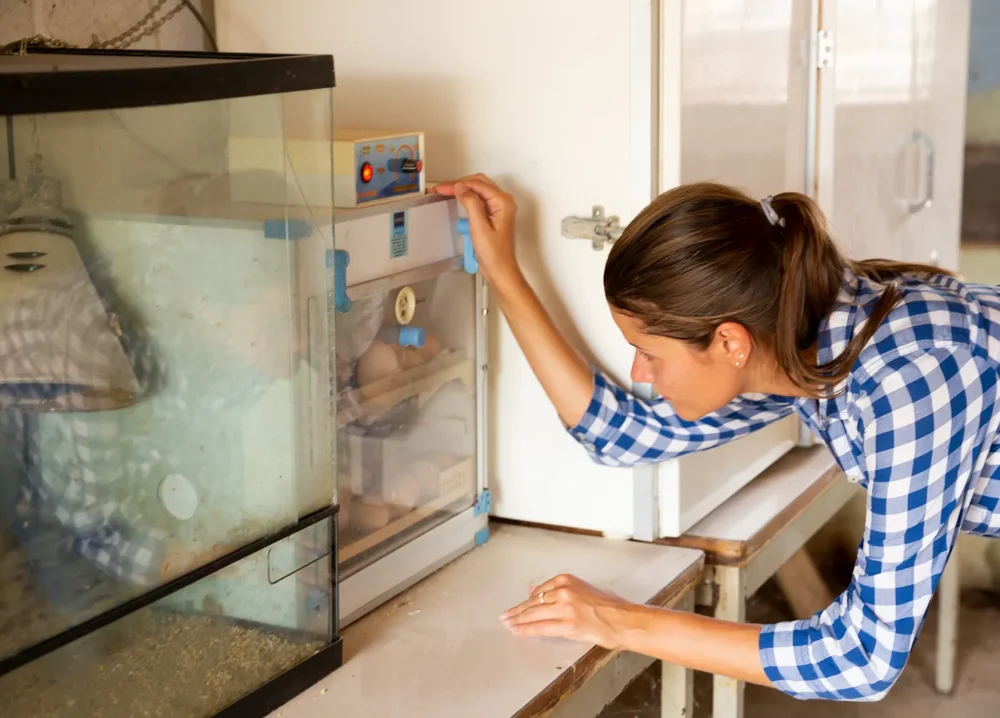
By Abigail Kuria, Elisa Lai, Lisa Kahuthu and Riley Macdonald of CLASP, Co-Secretariat of the Efficiency for Access Coalition
A new approach to product testing
More than 60% of the population of sub-Saharan Africa are smallholder farmers, yet Africa’s agricultural potential is largely untapped, with many tasks still carried out manually. Solar productive use equipment (PUE), which encompasses solar mills and egg incubators, can serve this critical market need by increasing the efficiency and profits of smallholder farmers living in off and weak-grid areas.
While the market for PUE is evolving rapidly, there is limited performance data to help market actors identify high-quality products. Despite VeraSol and other programs developing testing protocols for appliances and productive use equipment, these testing processes can be too stringent for emerging and nascent PUE technologies. Additionally, most PUE technologies may not have undergone independent testing given resource constraints of product manufacturers and distributors and the lack of standardised test methods.
Market actors need a consistent evaluation approach that can quickly respond to the PUE market’s evolving needs, support early market movers and enable the rapid deployment of quality products. This triggered us to develop a new approach for testing nascent PUE technologies. Rapid Product Assessment utilises a generic testing framework that is flexible enough for application to most types of PUEs. For cost-effectiveness, we work with local testing facilities and test only the most critical product attributes, reducing costs and testing times for companies.
Putting Rapid Product Assessment into practice for egg incubators
Poultry farming is common for rural households in Africa, especially amongst women and children, as it helps food self-sufficiency. In Cameroon, for example, traditional poultry accounts for more than 70% of farming activities. Still, an average of more than 43% of newly hatched chicks do not survive, causing significant financial and food security losses.
Egg incubators offer a solution by creating the optimal conditions and stable environment for eggs to incubate and hatch, enabling farmers to increase the success rate of hatching chicks. The consistency of temperature and humidity during the incubating period is highly critical to successful egg hatching. Depending on the type of bird, an egg incubator’s hatching period can range from 21 to 29 days, with chicken eggs typically taking 21 days. Over this 21-day hatching period, the temperature and humidity levels are adjusted based on the development stages of the embryos to optimise the hatching rate.
To validate the testing approach and understand the performance of an egg incubator, we carried out a pilot test on an incubator procured from a distributor in Kenya. The testing took place in two stages. The first stage was a controlled test to monitor energy consumption, temperature and humidity. The second stage involved collecting end-user feedback from a farmer in Alendu, Kisumu.
Controlled testing
We developed the test protocol to mimic the ambient conditions during the hatching process, but with a shortened duration of 10 days.
1. Pre-incubating period: We followed the product’s user manual to set up the egg incubator and visually inspect the machine. We prepared eggs for testing by marking an “x” on one side of the eggs, enabling us to observe the rotation of eggs during the incubating period.
2. Incubating period: During this period, the temperature was kept constant at 37.5 ⁰C and 50% relative humidity, which are optimal conditions for embryos to develop. The eggs required turning, either manually or using the automatic egg turner, two to three times a day to prevent the developing chick from sticking to the shell. Turning the eggs also ensures that the eggshell surface temperatures are consistent.
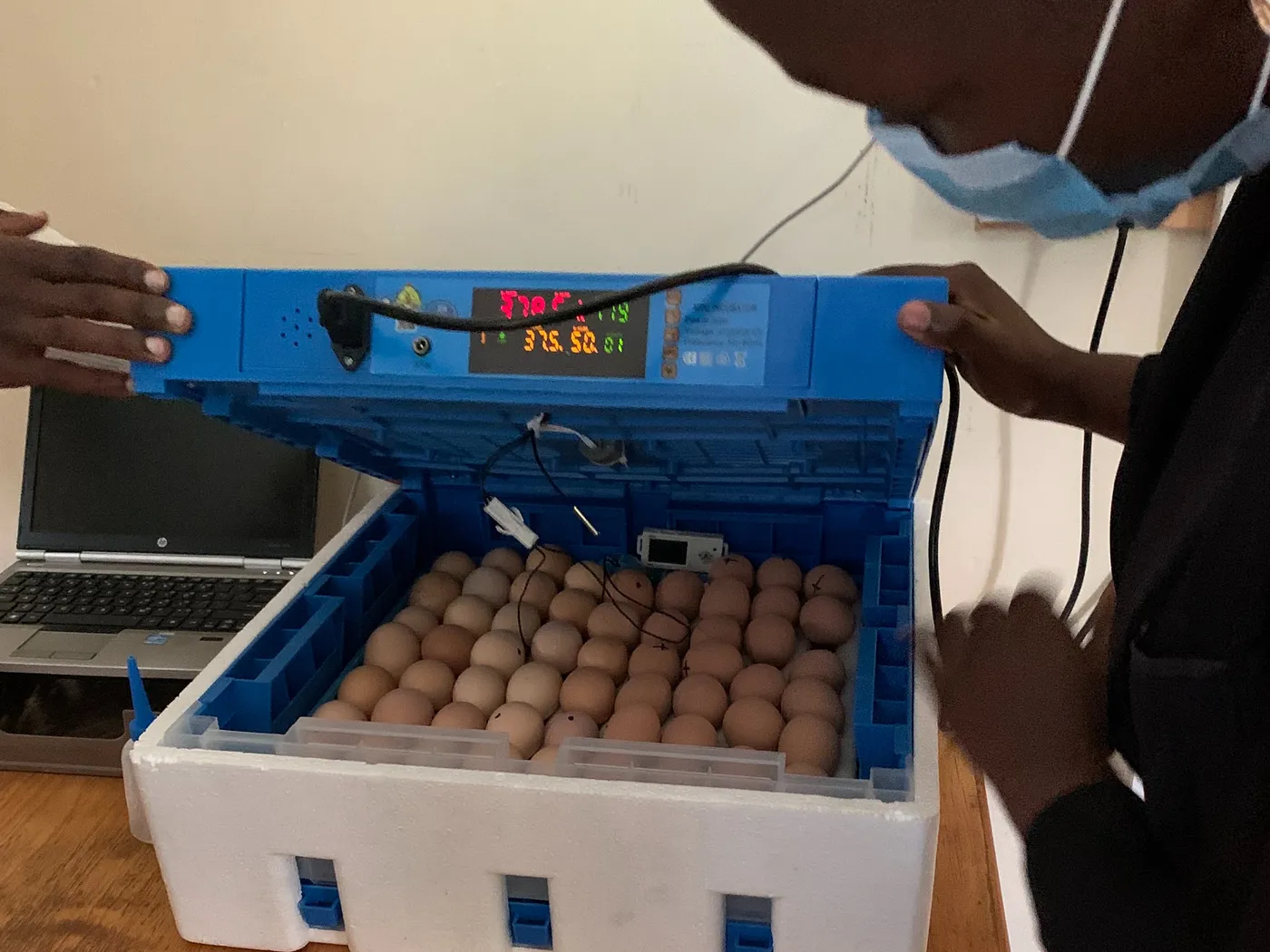
3. Lock-down period: During this period, we maintained the same temperature at 37.5 ⁰C, but increased the humidity to 65%. We laid the eggs horizontally to help the chicks get into a hatching position.
Controlled test results
- Ceramic eggs vs fertilised eggs: In the initial testing, we used two types of eggs to assess whether ceramic eggs can be an alternative to fertilised eggs for future testing. The test results showed that the average temperatures of ceramic and fertilised eggs are within +/-0.25 ⁰C, indicating ceramic eggs are a good proxy for fertilised eggs in controlled testing.
- Incubator capacity: Service delivery is one of the key evaluation points through the Rapid Product Assessment. In this case, we measured the maximum number of eggs that can fit in the incubating chamber to validate whether the manufacturer-advertised capacity of 64 eggs is accurate. During testing, we found that if we packed the chamber at 100% capacity, the eggs rubbed against each other because of the tight fit, resulting 10% of the eggs not being able to turn and increasing the risk of eggs breaking. With a lower capacity and too much spacing between eggs, 30% of the eggs only rolled partially and were able to rotate properly. We found the optimal capacity for this product to be 90% to allow some space for eggs to turn easily.
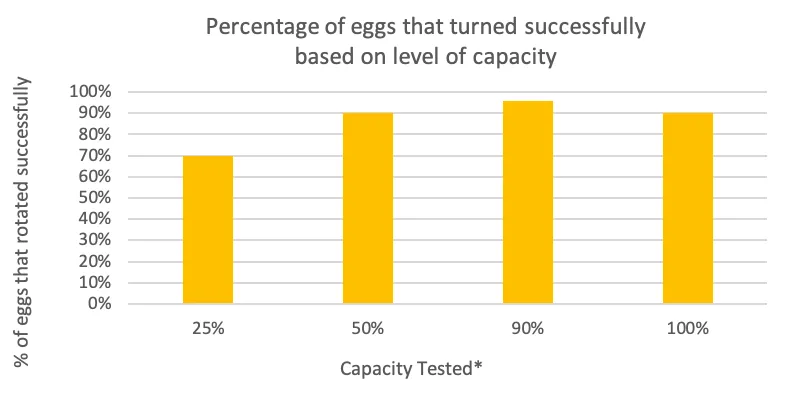
*100% capacity is determined based on the maximum number off eggs that can fit inside the incubator based on manufacturer’s advertised value.
- Temperature distribution: Temperature consistency, embryo temperature to be precise, is key to successful hatching. During the test, we measured the eggshell’s surface, which reasonably estimates whether the incubator is operating at the appropriate temperature. Ideally, the air temperature inside the incubator should be as close as to the temperature measurement on the eggshells. We measured the average temperatures of eggs placed in six different spots inside the chamber during the three days of testing. Overall, the temperatures were relatively consistent — although we noted that the egg temperatures recorded were below the recommended temperature at 37.5 ºC.¹ There was also some variation of temperatures depending on the egg placement within the incubator. The eggs in the centre rows had better temperature consistency, with only a 0.6ºC difference between the highest and lowest temperatures recorded. In comparison, eggs placed closer to the outer edges had a more considerable temperature variance.
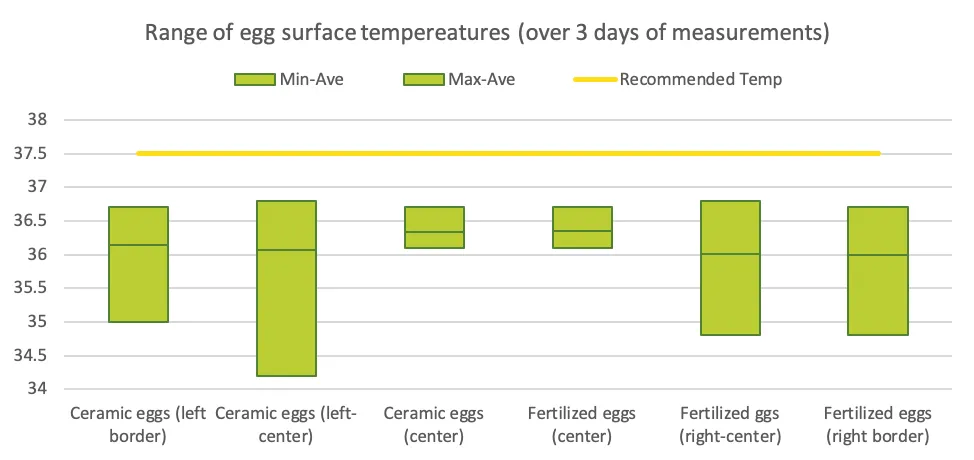
- Humidity: Humidity is another key aspect to ensuring embryos develop in optimal conditions and hatch successfully. Too high or low humidity can affect the weight of chicks and make the eggshell too hard for the chicks to peck out of during the hatching process. Generally, the humidity range is more forgiving than the temperature. However, the recommended humidity level during incubation is 45–50% and 65–70% during hatching. We found it challenging to maintain a constant humidity during testing, with levels varying widely from 39% to 71% for the sample. We also noted discrepancies between humidity levels shown on the control unit and those measured by the test lab, indicating potential room for improvements to the product’s humidity indicator.
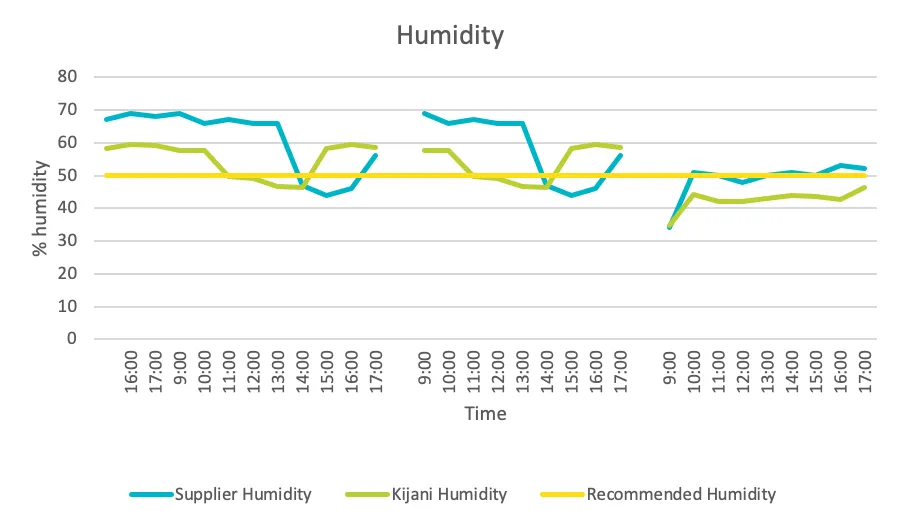
Field testing
To test how the egg incubator performed in real-life conditions and generate consumer insights, we partnered with Judy, a smallholder farmer in Alendu, Kisumu.
Based on the supplier’s information, the incubator should maintain the required temperature and humidity for up to 6 hours when disconnected from power. The incubator was off for about 2 hours during transportation from the office to the field site. We took this as an opportunity to measure how well it would maintain temperature and humidity when disconnected from power. The results showed that once power was turned off, the temperature drops — from 36.8 ⁰C to 33 ⁰C — within 2 hours, and the humidity rises quickly. This could severely affect the health of embryos and the achievement of a successful hatching rate.

Field testing results
We incubated 33 fertilized eggs during the field testing, and 26 of those had formed embryos. We gave the seven eggs with partially formed embryos to hens to sit on, and they later hatched successfully.
Of the 26 fully formed embryos, 69% hatched successfully, while eight (31%) of fully or partially formed embryos died. On further examination of the eight, we found that the shells were too hard, restricting the chicks from breaking out. This could result from high surface temperatures or low humidity, meaning there were no fluids in the shells. This further validates the importance of humidity and temperature consistency to the rate of successful hatches.

Customer feedback
In addition to the technical performance of the egg incubators, Judy provided additional insights on the product’s strengths and potential areas for improvement.
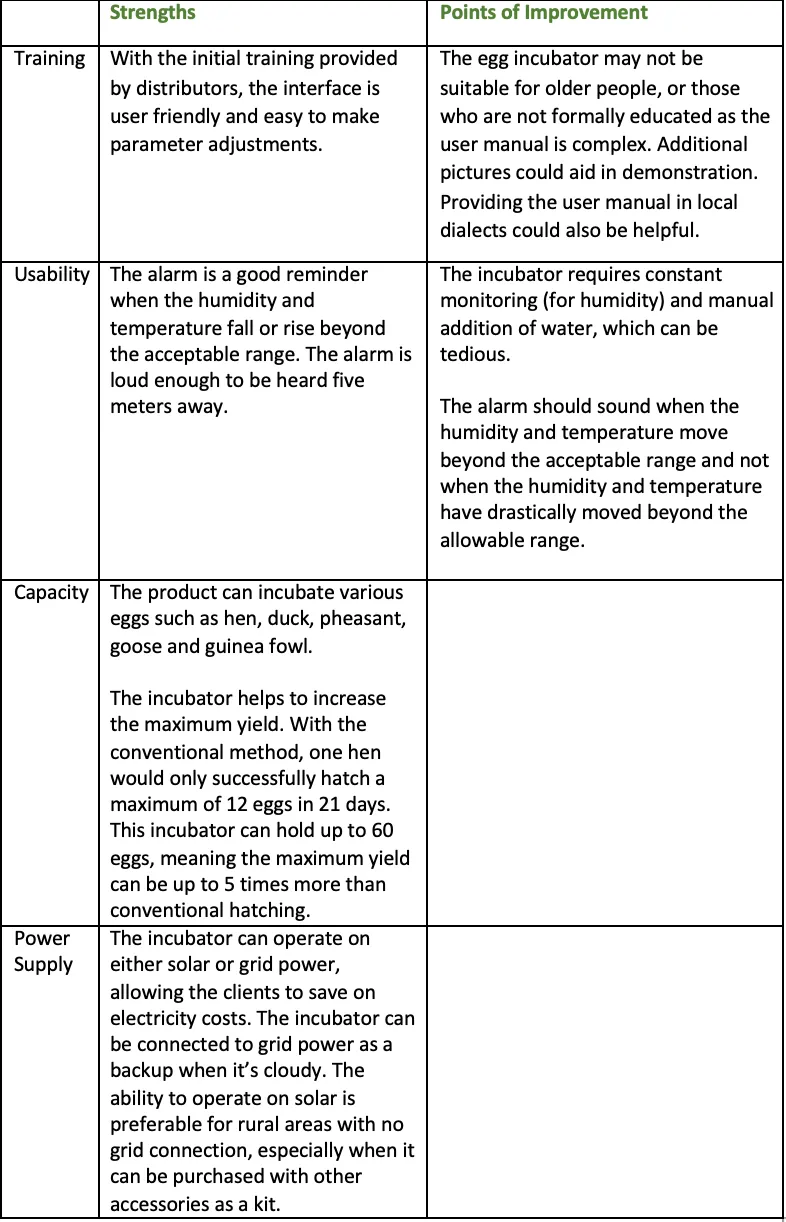
What’s next for egg incubators and other PUE?
Based on the learnings from this pilot testing, we have updated and improved the test protocols for egg incubators. We plan to publish these new protocols in December 2021 to enable other market actors, such as manufacturers, to test egg incubators. We will also continue to provide ad-hoc testing and performance evaluations for companies, programs, and others who submit egg incubators for testing.
In addition to egg incubators, we plan to expand the Rapid Product Assessment to motor-driven products, starting with solar milling. Solar mills are an increasingly popular and in-demand technology used by off-grid communities and small-scale farmers to improve grain digestibility for human or animal consumption. Similar to egg incubators, we will develop test protocols, perform beta-testing, and continue ad-hoc testing of solar mills.
If you are a program or manufacturer interested in beta-testing new PUE technologies through the Rapid Product Assessment approach, please reach out to us at info@verasol.org. Stay tuned for part two of this blog post, where we explore further insights on egg incubator performance from an interview with our local testing partner, Kijani Testing.
***
References
¹For optimum development in the incubator, the eggshell temperature should be within a range of 37.6–37.9 ºC (99.7- 100.2 ºF) during the first two-thirds of incubation and 38.1- 38.8 ºC (100.6–101.8 ºF) during the last days in the setter. https://www.thepoultrysite.com/articles/why-incubator-temperature-differs-from-egg-shell-temperature.